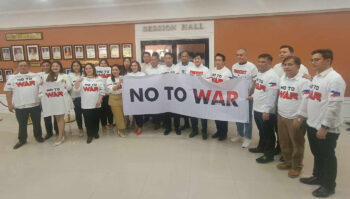DAVAO CITY (MindaNews/08 July) — Over the weekend, I travelled by bus for the first time to Baguio City, the country’s summer capital 5,000 feet up in the sky for a “green” event. No, definitely not the “green” you naughty guys have in mind.
The last time I was up there was during Holy Week several years ago in 2008 during President GMA’s time when I was press secretary. Cabinet members would join the president during the annual “retreat” for some much-needed meditation. All my life, before working in Malacanang, it was an exclusive, bonding time with family usually in the farm or in our hideaway in the mountain. I had to give that up when I worked for the president. I have not returned to Baguio since for about six years now.
BETTER THAN FLYING —I was back there, this time for a forum on “sustainable construction reporting” with the Philippine Press Institute and HOLCIM, Inc. attended by Luzon and Manila journalists. I was really planning on driving my car from Manila upon learning that Loakan Airport had been closed for a long time. But at the last minute, I was advised by my daughter Ning that it would be better taking the passenger bus. She was right. The 4-hour bus rides from Cubao in Quezon City to Baguio via the Marcos highway and back were totally pleasant. (Kennon Road is open only to light vehicles.) Victory Liner’s “de luxe” coach had airplane-type reclining seats, free wifi and TV, free snacks and bottled water on board with a uniformed attendant (like airline stewardess) with a cubicle-type restroom situated at the middle section. And unlike plane flights, the bus schedules were on the dot. I would have spent about P5,000 for gasoline alone if we drove up. Passenger fare was only P750 one way. While in Baguio, I missed the shivering cold temperature unlike in past years — due to global warming or climate change, maybe. But the populous mountainside looked as if it already exceeded its “carrying capacity” of development.
DON’T BAN PLASTIC — Now back to being “green”. I listened intently to the resource persons notably President Mike Guerrero of the Green Architecture Advocacy Phil. who surprised us with some “back to basics” principles that we, more often than not, took for granted. For example, he shook me with the proposition that non-biodegradable plastic bags should NOT be replaced by paper bags, as now being advocated almost everywhere. He said that paper bags are usually single-use items unlike plastics that are more durable. Moreover, paper bags are made from lumber and wood thus endangering our already disappearing trees and depleted, thinning forests. But plastics can be recycled and can be used for a myriad of other things. SO, THE ISSUE SHOULD NOT BE ABOUT PLASTIC PER SE BUT ITS DISPOSAL. Just because plastics clog our waterways and sewage systems should NOT be a reason to BAN them. The advocacy shift should be on WHERE we bring them or how we PROPERLY DISPOSE of them to prevent the negatives. It is in mishandling them rather than its use that should be the object of our campaign, if not anger. Just plain “common sense”, right? Now, after hearing that, I’ve changed my mind about pushing for paper bags. Someone whispered that some enterprising exporter must have planted this idea of shifting to paper bags to make oodles of money in the process. And our policy makers swallowed this hook line and sinker. I wonder.
SUSTAINABILITY — Of course, core of the discussions is on climate change and the need to survive due to global warming. And how “mitigation” (reducing the risks) and “adaptation” (adjusting to realities”) have a fine, thin line of difference. Mitigation is a proposition that is “too late and too little”, our resource person said. Perhaps we should work on “adaptation”. I also got a little new provoking thought about “resiliency” or our own people’s absorbing the shocks and still surviving and moving on. In fact this is touted as a good thing to be proud of. On close look, resiliency is NOT that desirable or some quality we should be proud of. It may connote something bad. Indeed, resiliency in our present context is all about not adjusting but just surviving. Being resilient is therefore not always desirable because it merely enamors our people but does not encourage them to improvise and craft new ways and devices.
Adaptation is perhaps more apt. Like the simple idea of returning back to the second floor of houses with posts or on stilts to counter flooding; or a return to the more adaptable horse-drawn calesa instead of stallable cars during floods. Or perhaps a modernized version jetski-type tricycles to navigate rising waters.
I was also fascinated at how the buzz-word “sustainable development” was defined. It was simply defined as “an instinct for survival.” Another discussant, Baguio Water District General Manager, Engr. Salvador Royeca described it as “meeting the needs of the present without compromising the ability of future generations to meet their own needs”.
SOME EXAMPLES — Being “green” is to be practical, economical and practicing sustainable development as generally defined by GM Royeca. But it is still at its infancy due to issues of costs, complexity and the usual resistance to change. For example, Architect Mike Guerrero talked of practical ways in building a “green” home or structure that are consistent with this practice. His tips include:
Keep the sun out, let the light in, catch the breeze, insulate the roof, harvest the rainwater, efficient lighting, use of renewable materials, and other steps where we “actively or passively work with nature”. It is interesting that HOLCIM’s best practices along these concepts were exemplified in its sponsored building of core shelters for calamity victims in the Compostela Valley areas destroyed by Typhoon Pablo. There, a sustainable barangay strategy was executed on the ground that included energy efficiency, water management, sustainable community. The design of the shelters was along the lines of the mentioned concepts and it will be interesting to revisit the sites to check-test the viability of this new strategy for possible replication in other areas in the future. (A planned visit to Comval will be done by PPI and Holcim soon.)
Other interesting vignettes mentioned included how to place solar panels to get the most sunlight ( in the southside where sunlight is available almost the whole day due to our position in relation to the equator) , the positioning of buildings and structures to minimize heating of the sun, (not predominantly facing east and west) the placement of windows to catch the breeze ( like windows from the floor up) the use of incandescent and LED bulbs ; the use of renewable energy : and various other tips that we always take for granted.
Oooops! I am on the run now just to catch the deadline. Next time, we will write some more about the specifics of how “greening” is the way to the future. (Author is the president/chair of the Philippine Press Institute, a national association of newspapers)






